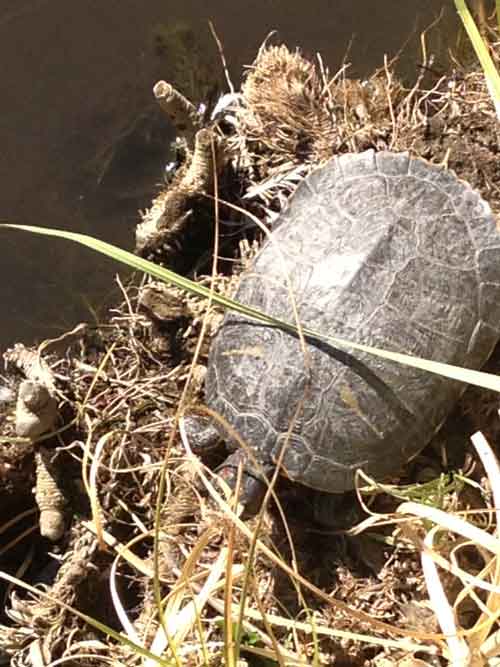Scientists show that red-eared sliders don't transmit common diseases to western pond turtles.
The western pond turtle (Emys marmorata ) in California has been in decline for decades thanks in part to the non-native red-eared slider, but the native turtle does not catch diseases from Trachemys scripta elegans, according to a study published in the journal Diseases of Aquatic Organisms. Scientists have long suspected that disease transmission was occurring from the red-eared slider to the western pond turtle, presumably contributing to the native turtle's decline. So researchers with the California Department of Fish and Wildlife, UC Davis School of Veterinary Medicine, the Hubbs-Seaworld Research Institute, and the U.S. Fish and Wildlife Service set out to determine the extent of disease transmission between the two species.
The researchers tested 10 populations of western pond turtles and red-eared sliders for Salmonella, Ranavirus, Mycoplasma, and Herpesvirus. The only disease that the turtles tested positive for was Mycoplasma, yet the researchers found no evidence that western pond turtles living in the same ponds as the red-eared sliders were more susceptible to the disease than those western pond turtles that lived in environments without the non-native turtle. So how is the red-eared slider pushing out the pond turtle? It appears the sheer size of the popular pet turtle is a contributing factor to the decline of the pond turtle, coupled with the conversion of the state's ponds and waterways in which the pond turtle lives to residential and agricultural use.
Want to Learn More?
Illegal Red Eared Slider Turtle Sales Continues In L.A.'s Chinatown And Fashion Districts
Salmonella Outbreaks Linked To Undersized Turtles
The western pond turtle grows to about 8 inches in carapace length while the red-eared slider can grow to 12 inches in carapace length, eating more of the same foods that sustain the western pond turtle and crowding basking spots in which the turtles compete.
The western pond turtle is native to California and much of the West Coast of the United States. Listed as vulnerable by the IUCN, the western pond turtle is an omnivore, subsisting on insects, crayfish and other aquatic invertebrates as well as plant matter. They are also known to eat fish, tadpoles and dead animal matter.

Photo by John B. Virata
A red-eared slider basking on the banks of a pond in a Huntington Beach, Calif. business park.
The red-eared slider is the most popular turtle in the pet trade, often sold as tiny juveniles only to grow to about a foot in carapace length. The red-eared slider is alos an omnivore, eating aquatic vegetation and animal matter including live and dead fish and other aquatic animals. They are native to the southern United States and northern Mexico, but have a near worldwide distribution due to its popularity as a pet turtle. The red-eared slider is on the International Union for the Conservation of Nature's List of the world's 100 most invasive species, one of two reptiles on the list.

